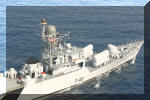Khukri (Type 25) Class
- Details
- Category: Ships
- Published: Wednesday, 23 August 1989 00:00
- Written by Corvette
- Hits: 24920
Vessel Type: Type 25 Corvette.
Names & Pennant Numbers with laid down, launched & commission dates:
INS Khukri P49; Laid Down - 27 Sep 1985, Launched - 03 Dec 1986, Commissioned - 23 August 1989.
INS Khutar P46; Laid Down - 13 Sep 1986, Launched - 15 Apr 1989, Commissioned - 07 June 1990.
INS Kirpan P44; Laid Down - 15 Nov 1985, Launched - 16 Aug 1988, Commissioned - 12 January 1991.
INS Khanjar P47; Laid Down - 15 Nov 1985, Launched - 16 Aug 1988, Commissioned - 22 October 1991.
Structure: The plan was to give the Type 25 vessels an ASW role. INS Khukri, however, has neither torpedo tubes nor sonar (apart from an Atlas Elektronick echo sounder), so they rely on a helicopter which has dunking sonar, depth charges and ASW (Anti-Submarine Warfare) torpedoes. All these vessels have fin stabilizers and full air conditioning.
Displacement: 1350 tons full load.
Dimensions: Length - 91.1 metres.
.................Beam - 10.5 metres.
.................Draught - 4.5 metres.
Main Machinery: 2 diesel motors with 14,400 hp, 2 shafts and cp props.
Maximum Speed: 25 knots.
Maximum Range: 4000 miles at 16 knots.
Complement: 79 (incl. 10 officers).
Radar: Air; One MR 352 Pozitiv-E (NATO: Cross Dome) radar at E/F-band frequency (range - 70n miles; 130km).
.........Air/Surface; One Garpun-Bal (NATO: Plank Shave) radar at I-band frequency.
.........Navigation; One Bharat 1245 radar at I-band frequency.
.........Fire Control; Refer to 'Weapons' sub-section.
Combat Data System: Selenia system fitted on INS Khukri, with the Bharat Vympel IPN-10 system fitted in the remaining three vessels.
Helicopter Capacity: Has a helicopter pad in the aft of the vessel, which carries the HAL Chetak. To be replaced by the Naval ALH in due course.
Weapons: Four P-20M (SS-N-2D) AShMs, in two twin-tube launchers, with infra-red homing (Mod 1) to 45n miles; 83km at Mach 0.9 with a 513 kg warhead. The missile becomes a sea skimmer at the end of run. Fire control is provided by a single MR-123 (NATO: Bass Tilt) radar at H/I-band frequency. Two Strela-2M (SA-N-5) SAM launchers, manual aiming with infra-red homing to 3.2n miles; 6 km at Mach 1.5 with a 1.5 kg warhead. Maximum altitude is at 2500 metres (8000 feet). One AK-176 76mm gun with 85º elevation, 120 rds/min to 8n miles; 15 km. Also has two 30mm AK-630 guns with 85º elevation, 3000 rds/min to 2 km.
Countermeasures: One Bharat Ajanta P Mk.II intercept is used in the ESM (Electronic Support Measures) role. Two PK-10 chaff launchers and one NPOL (Naval Physical & Ocenographic Laboratory) designed towed torpedo are used for decoy purposes.
Comments: These vessels were intended to replace the ageing Petya II Class corvettes. The first two were ordered in December 1984 and two in 1985. The diesel engines are assembled in India, under license by Kirloskar. Around 65% of the ship contains indigenous content.








